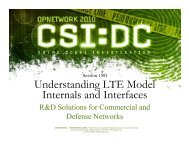Automated Axon Tracking of 3D Confocal Laser Scanning ...
Automated Axon Tracking of 3D Confocal Laser Scanning ...
Automated Axon Tracking of 3D Confocal Laser Scanning ...
You also want an ePaper? Increase the reach of your titles
YUMPU automatically turns print PDFs into web optimized ePapers that Google loves.
The number <strong>of</strong> cross-sections to be analyzed by the algorithm is assumed to be known by theuser. The user also needs to identify the best MIP image for analysis by looking at the MIPimages along the three orthogonal directions. A rough estimate <strong>of</strong> the width <strong>of</strong> the biggest axonin this MIP image has to be specified by the user. The resolution <strong>of</strong> the grid for the detection <strong>of</strong>seed points in the MIP image needs to be defined such that there are at least a few candidate seedpoints on each <strong>of</strong> the axons in the MIP image. Small values <strong>of</strong> step size <strong>of</strong> the MIP-basedtracking algorithm results in higher accuracy in tracking, but increases the execution time <strong>of</strong> thealgorithm. On the other hand, large values lead to faster tracking, but can result in tracking errorsand a coarse centerline. In all the datasets presented in this paper, this value was set to 3 pixels.Once the algorithm switches to the cross-sectional tracking, the user has to specify the seedpoints for the cross-sections <strong>of</strong> the axons that have not yet been tracked in the MIP image. This isdone only for the first cross-sectional image where the algorithm switches to a different method<strong>of</strong> analysis.The results <strong>of</strong> our algorithm were validated with the manual reconstruction results that wereobtained using Reconstruct. Finally, the performance <strong>of</strong> the guided region growing algorithm iscompared with the repulsive snake model on one cross-sectional image from each <strong>of</strong> the threedatasets.The first dataset contained four axons in total with 256 cross-sectional images, each having aresolution <strong>of</strong> 141 x 512 pixels. The cross-sectional images were sampled along the Y direction.Figure 10(a)-(b) show the MIP image and the cross-over <strong>of</strong> axons in the MIP image. Themaximum width <strong>of</strong> the axon was set to twenty pixels and the resolution <strong>of</strong> the grid for the MIPimage was set to ten pixels. Figure 10(c) shows the manual reconstruction <strong>of</strong> the axons. The 2DMIP and the <strong>3D</strong> model <strong>of</strong> the centerlines are shown in Figure 10(d)-(e).24















